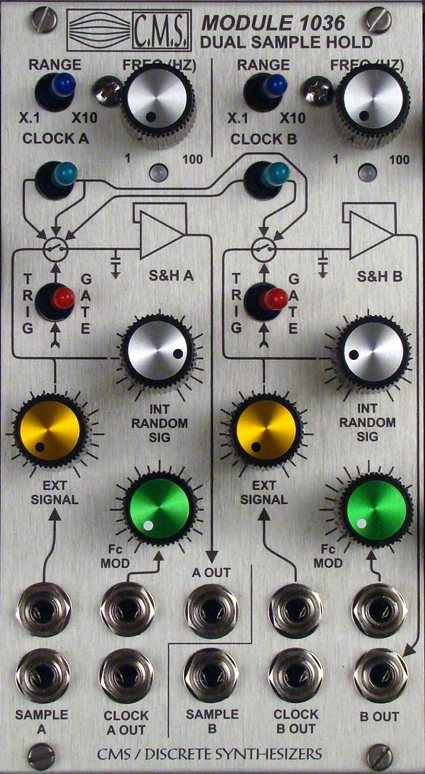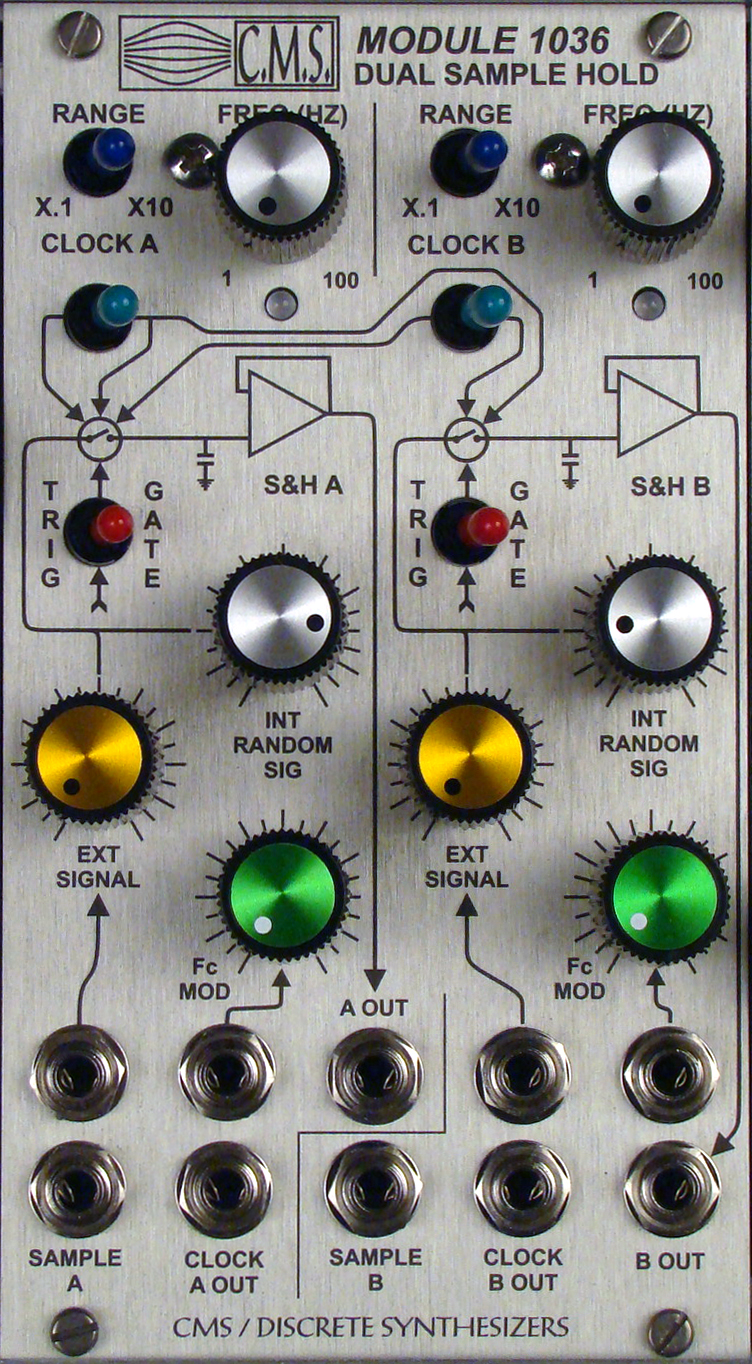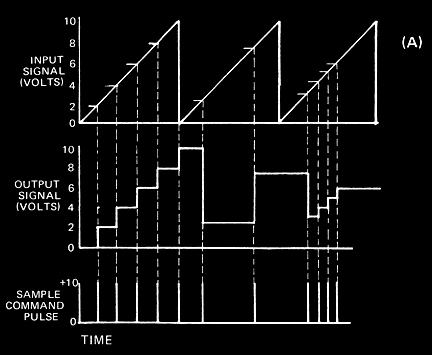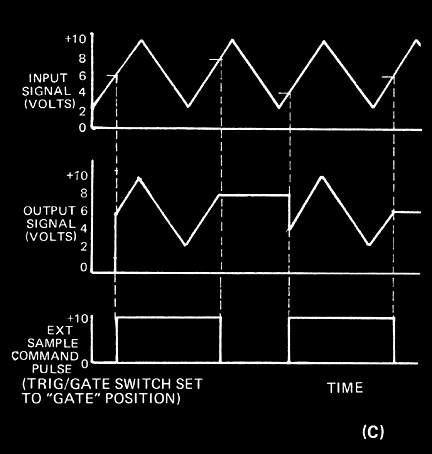 |
||||
| DUAL SAMPLE AND HOLD / V.C. CLOCK | ||||
FEATURES:
- EXTERNAL SIGNAL AND TRIGGER / GATE INPUTS
- HIGH SPEED OPERATION OF S/H FOR AUDIO PROCESSING
- INTEGRATED VOLTAGE CONTROLLED CLOCKS
- CLOCK RANGE SWITCHES ENABLE AUDIO FREQUENCY OPERATION
- VOLTAGE CONTROLLED CLOCKS HAVE SEPARATE PULSE OUTPUTS
- TWO INTEGRATED SEMICONDUCTOR NOISE SOURCES
CONSTRUCTION:
- HIGH QUALITY ELECTRONIC COMPONENTS, HAND ASSEMBLED AND TESTED
- MILITARY GRADE HARDWARE, POTENTIOMETERS, JACKS, KNOBS
- HI RESOLUTION, CLEARLY LAID OUT, BLACK ANODIZED FRONT PANEL
- SUB-MODULAR DESIGN PROVIDES EASY SERVICE, UPGRADES
- STABLE S/H MEMORY CIRCUIT - DRIFT FREE
- 2 GENUINE ANALOG NOISE SOURCES

| The CMS 1036 Dual
Sample & Hold/Random Voltage module is a functional circuit
package designed for use with the CMS series 1000 Electronic Music
Modules. The module contains two sample and hold circuits, two random
noise generators, and two voltage controlled pulse generators. The
1036 is usually used in conjunction with CMS/ARP voltage controlled
oscillators to produce random tone sequences, scales, arpeggios
and programmed melodic patterns. The module can also be used to
control voltage controlled filters, amplifiers, etc. A sample and hold circuit has a signal
input, a signal output, and a sample command input. When a pulse
is applied to the sample command input, the output signal voltage
immediately assumes the same value as the input signal voltage.
In the case of the 1036 sample and hold circuits, this process takes
about 10 microseconds. After the sample command pulse, the output
signal voltage will hold at that same level until another sample
command pulse is applied. During the holding period between pulses,
the input signal has no effect on the output signal. In the case
shown in Figure A, a sawtooth waveform is applied from an external
oscillator to the "Ext Sig" input of a 1036 sample and
hold. Sample command pulses can be generated by pushing the "Single
Sample" button, applying an external pulse (as from an oscillator
or keyboard trigger) to the "Sample" input (with the "Trig/Gate"
switch set to "Trig"), or by using an internal clock pulse
generator. There are two separate clock pulse generators. The frequencies of the clock pulse generators are determined by the front panel "Clock Freq" knobs and range switches. An external signal applied to the "Clock Freq Mod" inputs will also affect clock frequency. The 2 toggle switches directly beneath the range switches are the clock routing switches that determine the destination of the clock signals. The clock (a) routing switch on the left assigns the clock pulse (a) as follows: Left position connects clock (a) to sample and hold (a). The center position is (off). The right position assigns clock (a) to both the (a) and (b) sample and hold circuits The clock (b) routing switch on the
right assigns clock pulse (b) as follows: Left position connects
clock (b) to sample and hold (a). The center position is (off).
The right position assigns clock (b) to sample and hold (b). The "Clock Pulse" output
is a 10 volt pulse that corresponds to the sample period of any
sample command pulse reaching the sample and hold circuit. The internal
clock, the "Single Sample" button, or external pulses
all produce pulses at the "Clock Pulse" output. Usually
this pulse can be used to trigger envelope generators, sequencers,
and so forth. When a sample command pulse is received
from the clock, "Single Sample" button, or external pulse,
the output voltage appearing at "Out (a)" or "Out
(b)" assumes the same value as the input voltage. In the case
of Figure A, a sawtooth wave going from 0 volts to +10 volts is
sampled at irregular intervals by the application of sample command
pulses.
Any external signal which one desires
to sample must be applied to the "Ext Sig" inputs. The
knobs associated with the "Ext Sig" inputs are used to
attenuate the incoming signal. The output voltage from the sample
and hold circuit will usually be a series of steps or discrete voltages.
The output signal shown in Figure A is typical. Normally this output
signal is used to control voltage controlled oscillators, filters,
amplifiers, and so forth. If a waveform is sampled at a high enough
frequency, however, the output signal can be used as an audio source. In addition to sampling external signals,
the module 1036 has built-in random signal generators. By advancing
the front panel knobs labeled "Int Random Sig", noise
can be applied to the signal input of the sample and hold circuits.
When this random signal is sampled by the application of a sample
command pulse, the output signal is a series of stepwise random
voltages, as shown in Figure B. If an external signal is also applied,
the random signal and the external signal will be mixed internally
before being sampled.
When an external sample command pulse (as from an oscillator) is applied to the "Sample" input, two different results can be selected by the "Trig/Gate" switch. In the "Trig" position, the input pulse is differentiated and the leading or positive-going edge of the external pulse triggers the sampling circuit for 10 microseconds. The duration of the external pulse under these conditions is immaterial. When the "Trig/ Gate" switch is in the "Gate" position, the output signal of the sample and hold circuit will track the input signal as long as the external sample command pulse is positive. As soon as the pulse ends and the voltage at the "Sample" input returns to zero, the sample and hold circuit will store and hold the last value of the input signal voltage before the sample command pulse returned to zero. Figure C shows an example; when the sample command pulse is high, the output signal tracks the triangle wave at the signal input. When the sample pulse goes to zero volts, the output signal voltage holds at the voltage which was present when the sample command pulse dropped to zero.
THE 1036 SAMPLE & HOLD CIRCUITS ARE BUILT FOR HIGH SPEED OPERATION. THE SAMPLE COMMAND PULSE CAN BE CLOCKED AT AUDIO FREQUENCY FOR COMPLEX EFFECTS. ALSO THE SAMPLE & HOLD CIRCUIT IS CAPABLE OF PROCESSING AUDIO FOR GRANULAR DIGITAL EFFECTS.
|
| ELECTRICAL SPECIFICATIONS: INPUTS:
OUTPUTS:
SIZE SPECIFICATIONS:
|
||

 |
||||||
| e-mail: filter@discretesynthesizers.com Phone: 912-727-2195 |
||||||
| ©2024 Phil Cirocco | ||||||


